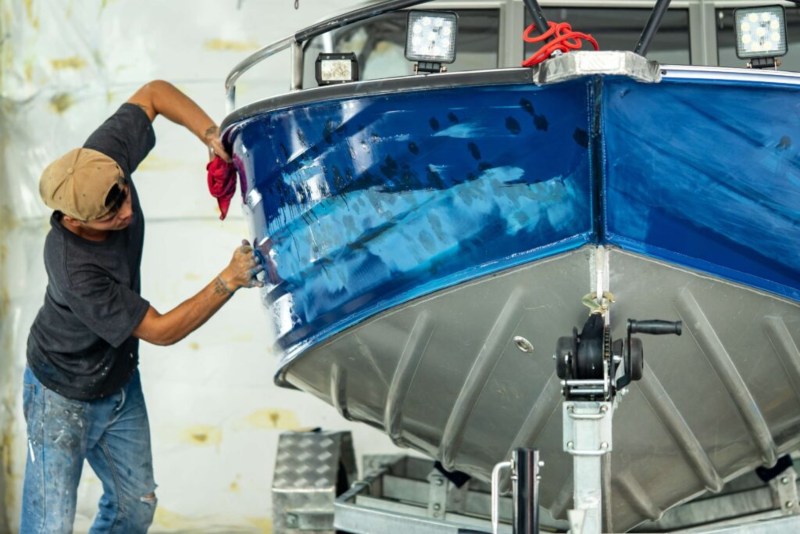California Yacht Marina
Saltwater Boat Maintenance
If you own a boat in Southern California, chances are you sail on the ocean. This exposes your boat to salt water, which is hard on the engine, hull, upholstery, and other components. The longer you go without performing basic maintenance, the more likely your boat is to have issues. Fortunately, with this saltwater boat maintenance guide, you can keep your vessel looking and running great for many more years of cruising up and down the coast.
Maintaining a Saltwater Boat Engine
Like a car engine, boat motors require maintenance, especially those that sail on the ocean. A well-maintained engine will last years longer than a neglected one, so giving it some attention is worthwhile.
Inspect the engine anytime you head out on your boat. Follow these steps:
- Check the water intake.
- Top off the fuel level.
- Check your oil level. Change it as often as recommended in the owner’s manual.
- Check the coolant and power steering levels.
- Keep an eye on engine belts and clamps.
- Check the spark plugs and replace them if you see rust.
- Check the fuel hoses for cracks or other damage.
Flush the outboard with fresh water within 24 hours of every saltwater trip. The process depends on whether your boat has a built-in flush connection. If not, you’ll need to use flush muffs or flushing bags. Consult your owner’s manual for specific instructions. The most important thing to remember is to never run the engine dry.

Maintaining a Saltwater Boat Hull
A clean boat is about more than just looking nice. The gel coating on a fiberglass hull must be cleaned regularly to avoid oxidation, which makes the hull look chalky and waxy and weakens the boat’s structural integrity. Salt can also corrode the metal fasteners that hold your boat together, another good reason to prioritize maintenance. Clean the hull every four to 12 weeks following these steps:
- Inspect the hull for dents, cracks, or scratches that need repair.
- Check the drain plugs to ensure they are secure and in good condition.
- Rinse the hull with fresh water to remove dirt and algae.
- Apply an eco-friendly boat cleaner designed for your hull’s material.
- Wipe the boat down with a large sponge using gentle, circular motions. Scrub from bow to stern and rinse with fresh water when finished.
- Remove hard-set grime and barnacles with a stronger hose and more elbow grease.
Cleaning Saltwater Boat Upholstery
Good quality boat upholstery should resist mold growth and sun damage. Even so, fading, cracking, and bubbling can occur if the vinyl goes years without maintenance. Mold and mildew can also make your boat look and smell terrible. To prevent these problems, clean the upholstery at least twice a year. Here’s how:
- Sweep the cracks and crevices with a soft-bristled brush.
- Apply a vinegar solution to remove mold from boat upholstery. Fill a spray bottle with diluted vinegar and thoroughly saturate all moldy surfaces. Allow the solution to sit for several minutes, rewetting as needed.
- Rinse all treated surfaces with warm water. Scrub any stubborn spots with a sponge.
- Dry off excess moisture with a microfiber cloth.
- Apply a marine fabric protector to guard against UV rays, stains, and salt spray that could wear out your upholstery.
Inspecting Other Parts of a Saltwater Boat
Other miscellaneous parts of your boat also need attention. Here’s what to check:
- Inspect the battery for corrosion and clean the connectors with a wire brush. Measure the charge with a multimeter a few times per year. If the reading is under 13.2 volts, replace the battery.
- Check the propeller to ensure it’s clear of fishing line, weeds, and other debris. Also, look for breaks, dents, or other signs of damage. Make sure the nut is secure, and grease the shaft about twice a year.
- Inspect the bilge pump for corrosion, inspect the hoses for damage or debris buildup, and clean the bilge after 50 hours of operation.
- Examine the electrical lines, straightening them if needed. Check finicky electrical components with your multimeter to help diagnose problems.
Use Safe Cleaning Products & Practices
The California Coastal Commission’s Water Quality Program encourages boaters to use environmentally friendly boat maintenance and cleaning methods. You can avoid polluting the water in two ways:
- Choose non-toxic, phosphate-free, biodegradable cleaning products such as baking soda, vinegar, lemon juice, and vegetable oil. Even these alternatives to bleach, ammonia, strong acids, and lye should be used sparingly because they could still adversely affect aquatic life.
- Keep cleaning products out of the water by maintaining a physical barrier or containment system while cleaning. Suggestions include using drop cloths, plugging openings that drain into the surrounding water during maintenance, recycling hazardous materials, and vacuuming or sweeping loose debris for proper disposal.
While minor cleaning can take place at a boat slip, significant repairs and maintenance should be restricted to boatyards, where specialized equipment and management practices keep pollutants out of the water.
Rent a Boat Slip at California Yacht Marina
Maintenance isn’t the only aspect of responsible boat ownership. You also need a safe, secure location to store your vessel when you’re not cruising on the open water. Renting a boat slip could be the perfect option because your boat stays conveniently on or near the water, preventing you from towing it back and forth. Depending on how often you go boating, this could be a huge time-saver.
Turn to California Yacht Marina for affordable boat slip rentals in Southern California. We helm three separate marinas—Cabrillo, Wilmington, and Port Royal—each of which features onsite amenities and exceptional customer service for peace of mind when you’re not using your vessel. To learn more about renting a boat slip, please call 424-201-0467, send us an email, or fill out our online contact form. You can also call ahead to schedule a tour of our facilities to ensure we’re the right fit for your needs.
